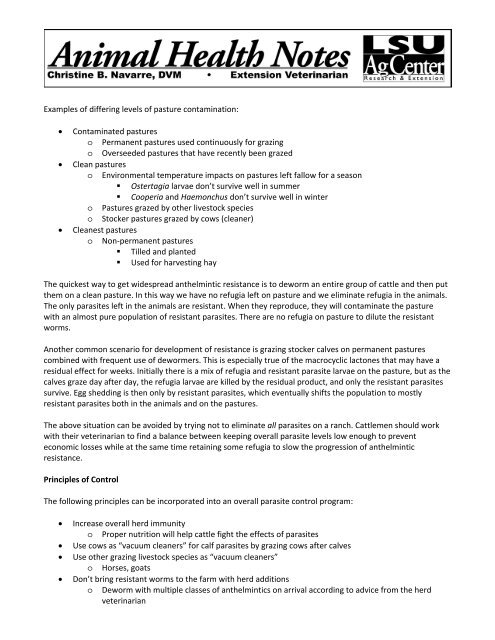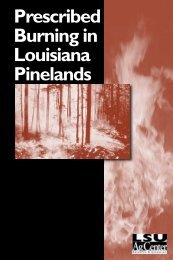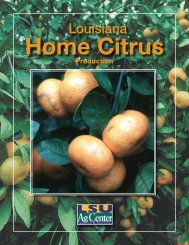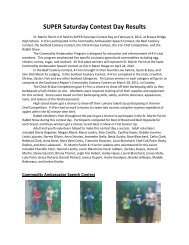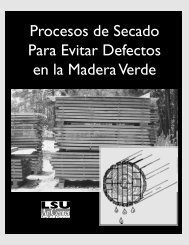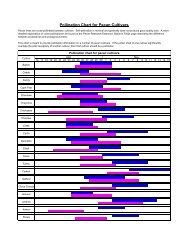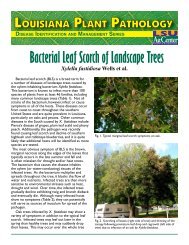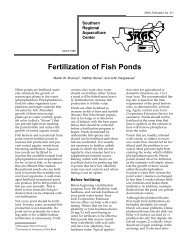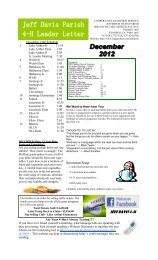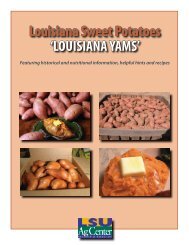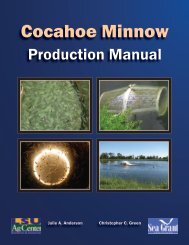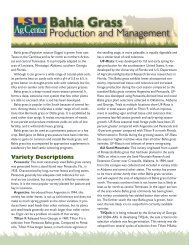Best Management Practices Parasite Control in Beef Cattle
Best Management Practices Parasite Control in Beef Cattle
Best Management Practices Parasite Control in Beef Cattle
Create successful ePaper yourself
Turn your PDF publications into a flip-book with our unique Google optimized e-Paper software.
Examples of differ<strong>in</strong>g levels of pasture contam<strong>in</strong>ation:<br />
<br />
<br />
<br />
Contam<strong>in</strong>ated pastures<br />
o Permanent pastures used cont<strong>in</strong>uously for graz<strong>in</strong>g<br />
o Overseeded pastures that have recently been grazed<br />
Clean pastures<br />
o Environmental temperature impacts on pastures left fallow for a season<br />
• Ostertagia larvae don’t survive well <strong>in</strong> summer<br />
• Cooperia and Haemonchus don’t survive well <strong>in</strong> w<strong>in</strong>ter<br />
o Pastures grazed by other livestock species<br />
o Stocker pastures grazed by cows (cleaner)<br />
Cleanest pastures<br />
o Non‐permanent pastures<br />
• Tilled and planted<br />
• Used for harvest<strong>in</strong>g hay<br />
The quickest way to get widespread anthelm<strong>in</strong>tic resistance is to deworm an entire group of cattle and then put<br />
them on a clean pasture. In this way we have no refugia left on pasture and we elim<strong>in</strong>ate refugia <strong>in</strong> the animals.<br />
The only parasites left <strong>in</strong> the animals are resistant. When they reproduce, they will contam<strong>in</strong>ate the pasture<br />
with an almost pure population of resistant parasites. There are no refugia on pasture to dilute the resistant<br />
worms.<br />
Another common scenario for development of resistance is graz<strong>in</strong>g stocker calves on permanent pastures<br />
comb<strong>in</strong>ed with frequent use of dewormers. This is especially true of the macrocyclic lactones that may have a<br />
residual effect for weeks. Initially there is a mix of refugia and resistant parasite larvae on the pasture, but as the<br />
calves graze day after day, the refugia larvae are killed by the residual product, and only the resistant parasites<br />
survive. Egg shedd<strong>in</strong>g is then only by resistant parasites, which eventually shifts the population to mostly<br />
resistant parasites both <strong>in</strong> the animals and on the pastures.<br />
The above situation can be avoided by try<strong>in</strong>g not to elim<strong>in</strong>ate all parasites on a ranch. <strong>Cattle</strong>men should work<br />
with their veter<strong>in</strong>arian to f<strong>in</strong>d a balance between keep<strong>in</strong>g overall parasite levels low enough to prevent<br />
economic losses while at the same time reta<strong>in</strong><strong>in</strong>g some refugia to slow the progression of anthelm<strong>in</strong>tic<br />
resistance.<br />
Pr<strong>in</strong>ciples of <strong>Control</strong><br />
The follow<strong>in</strong>g pr<strong>in</strong>ciples can be <strong>in</strong>corporated <strong>in</strong>to an overall parasite control program:<br />
<br />
<br />
<br />
<br />
Increase overall herd immunity<br />
o Proper nutrition will help cattle fight the effects of parasites<br />
Use cows as “vacuum cleaners” for calf parasites by graz<strong>in</strong>g cows after calves<br />
Use other graz<strong>in</strong>g livestock species as “vacuum cleaners”<br />
o Horses, goats<br />
Don’t br<strong>in</strong>g resistant worms to the farm with herd additions<br />
o Deworm with multiple classes of anthelm<strong>in</strong>tics on arrival accord<strong>in</strong>g to advice from the herd<br />
veter<strong>in</strong>arian


